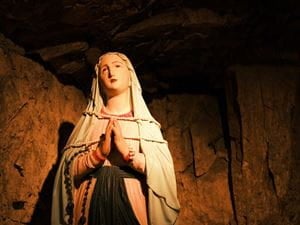
Jesus’ mother, Mary, is undoubtedly the senior saint within Christianity, yet we don’t know much about her. The New Testament says nothing about her birth, age, appearance, or death. Outside of the stories of Jesus’ birth in Luke and Matthew, Mary is mentioned explicitly in only three other events in Jesus’ life.
She was at the wedding where Jesus turned water into wine, she tried to see Jesus when He was teaching, and she was present at His crucifixion.
Mary's early life.
In biblical times, Jewish marriage customs were different from modern Western traditions. Most couples in the West marry for love, and according to recent census findings, most U.S. couples get married at about 31 years old, a 10-year increase from the average marriage age in 1950 at 21 years old.
However, in ancient times, Jewish families arranged marriages for their children while they were still young. Most Jewish girls from 12 to 15 years old were promised to young men aged 18 to 19. The reason behind these early arranged marriages was practicality. A girl was considered ready for marriage when she could bear children, a milestone marked by the start of her monthly cycle.
A young man was considered ready for marriage when he mastered the necessary family support skills. Jewish marriages were contracted between the bride and groom’s families within a narrow circle of familial clans. Marrying outside one’s clan was considered taboo due to the fear that foreign practices would defile their beliefs and other tribes would take possession of the family property. This is one reason Joseph and Mary’s genealogies originate from the same ancestral lines.
According to Jewish tradition, Mary’s father likely consulted her about making Joseph her husband, but only as a formality after they settled Mary’s bride price. In those days, it made sense for the groom’s family to offer compensation for a wife. The groom would continue to live and work in his father’s home after the wedding with his new bride. On the other hand, the bride’s family lost a profitable and valuable household member.
After their betrothal, Joseph and Mary probably didn’t contact each other for up to a year. They had to wait for their wedding ceremony and the consummation of their marriage. The bride’s virginity was treasured and protected. The bride and groom weren’t allowed to be alone before their wedding night, even though they were legally married. God sent Gabriel to visit Mary during her and Joseph’s betrothal to tell her she was chosen to bring the Son of God into the world. Mary couldn’t understand how this could happen since she was a virgin. However, the angel assured her that the Holy Spirit would achieve this mission. With that, Mary joyfully and humbly agreed to the task.
If the angel hadn’t visited Joseph and convinced him that Mary’s pregnancy was an act of the Holy Spirit, he could’ve divorced her for infidelity. Luckily, he chose to stick by her, and the couple raised Jesus until He started His earthly ministry.
How did Mary die?
Mary is last mentioned in the Bible when the Holy Spirit came upon her on the day of Pentecost in Acts 2:1-4. After that day, we don’t hear much more about Mary. According to John 19:27, Mary likely lived in John’s home for her remaining years, but we don’t know where John lived. He may have had a home in Ephesus or Jerusalem.
Some suggest that, since John probably oversaw numerous churches in Asia Minor, Mary moved to Ephesus with John and joined the Ephesian church where Timothy pastored. However, we still don’t know for sure. One tradition suggests that Mary died in AD 43, while another says she died in AD 48, but neither date has been confirmed.
Legends and traditions try to detail what might have happened to Mary in the years after Pentecost. One story says that Mary never lived in Ephesus. Instead, she lived in a small stone house built on a hill on the road outside Jerusalem. This legend also says that her home included an alcove and prayer chapel where she put a cross. Per the legend, behind her house, Mary put up memorial stones marking various stations of the cross. Another story says that sometime after Jesus’ crucifixion, Joseph of Arimathea took Mary to Glastonbury in southern England, where she lived out her remaining days.
It also says that Mary was buried with the Holy Grail. However, neither of these legends are validated by historical evidence. In the 1800s, Catholic mystic Catherine Emmerich claimed she had a vision where she saw Mary’s last minutes. In the vision, Catherine describes the apostles’ presence at Mary’s deathbed. Peter gave the Mass and extreme unction to Mary. She died at the same hour as Jesus, and her spirit ascended into heaven. However, we have no reason to believe anything from Catherine Emmerich’s vision.
Ultimately, we must accept that little information surrounds Mary’s later life and death. The Bible focuses on Jesus’ death, resurrection, and continuous work via the Holy Spirit. Although more than incidental to Christ’s story, Mary’s story is subordinate. Although God chose Mary for a unique assignment, we know she had to receive salvation through her faith in Jesus, as we all do.
Mary is in heaven with the believers who died in Christ, not because she was Jesus’ mother, but because she trusted His bloodshed as payment for her sins. We all know that Mary plays an integral role in the Bible. As a teenager, God chose her to carry the Son of God so He could save the world from sin. Mary watched Jesus grow from a child to a man and, sadly, had to watch as He was crucified and resurrected.
Unfortunately, the Bible doesn’t say much about Mary after Jesus’ death. We can assume she died naturally, but we don’t know. However, we know that Mary’s faith is admirable, and we should all hope to have faith as strong as hers.

